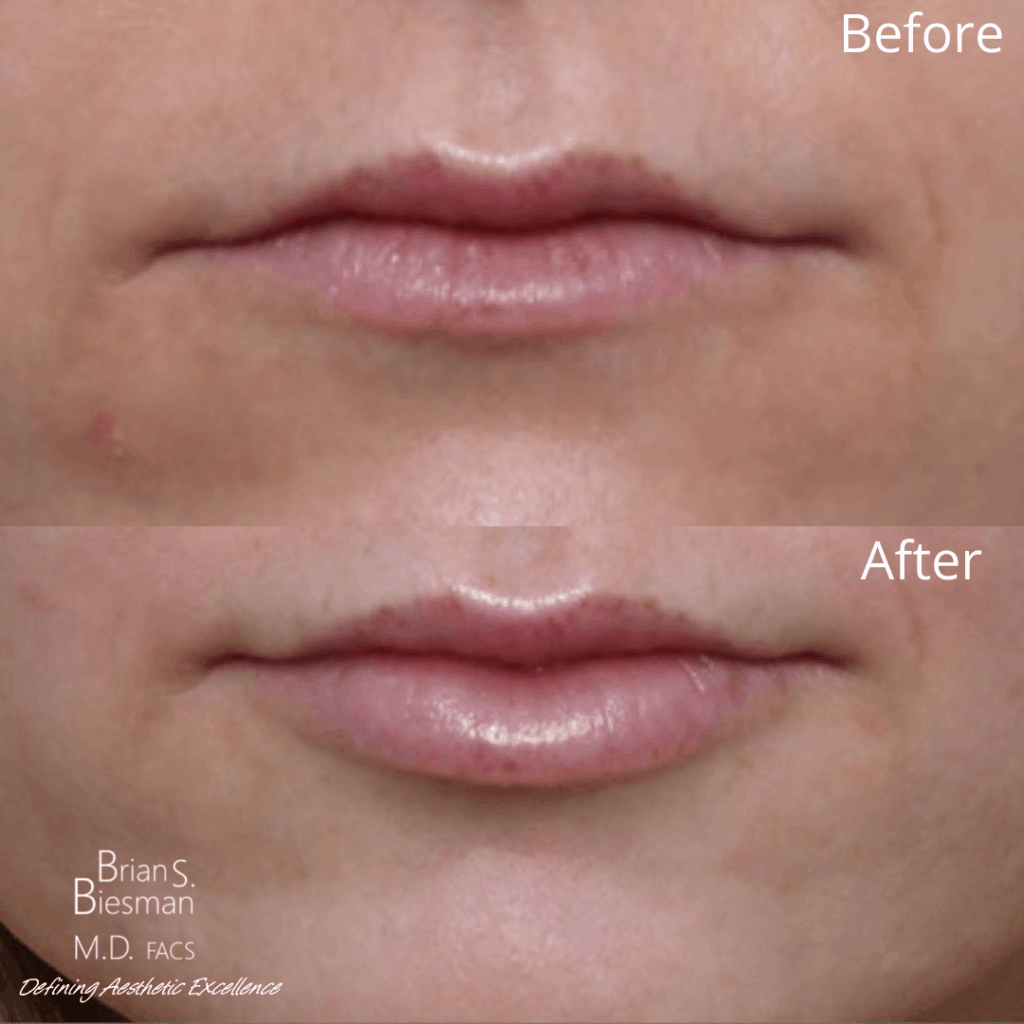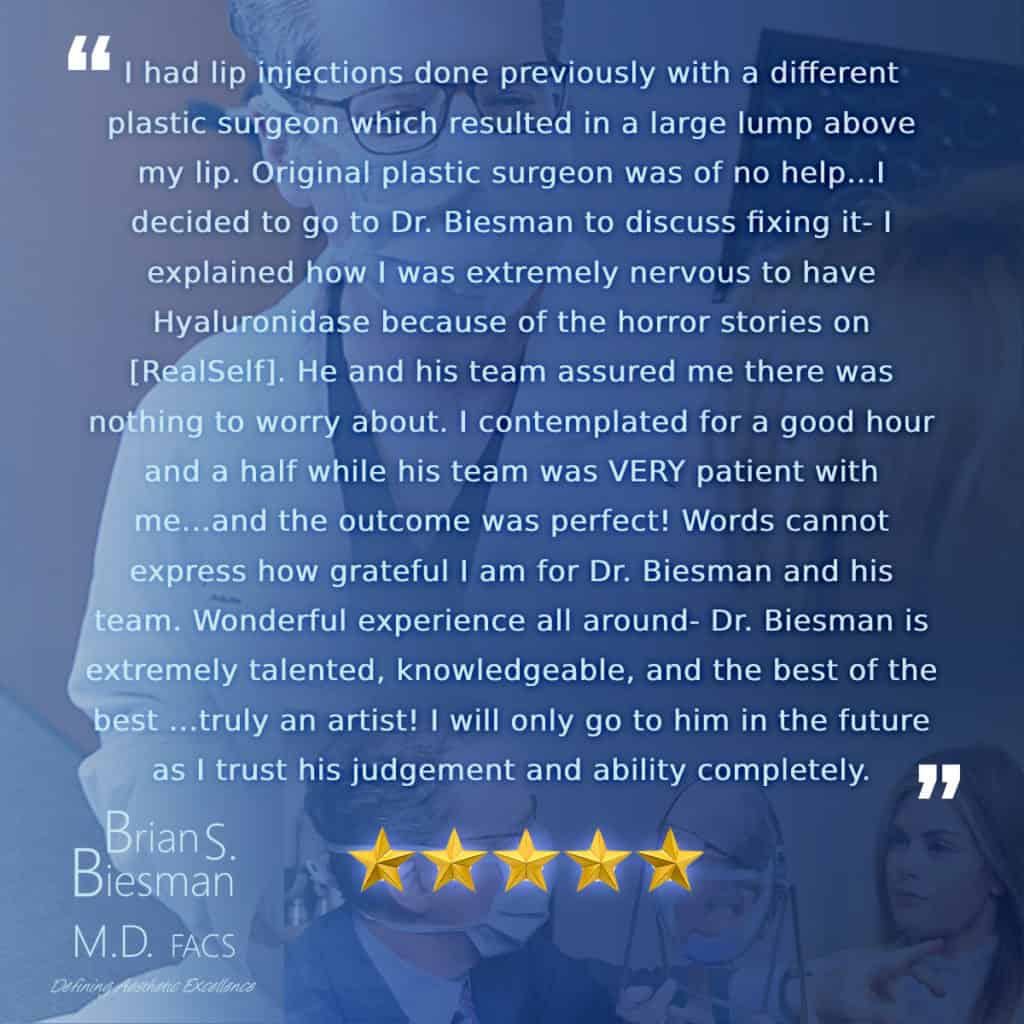Many patients are aware of dermal fillers, which can be injected into the skin to produce a “plumping” effect. In recent years, these injectable fillers for facial shaping and contouring have gained considerable popularity as a safe, non-surgical option.
Before getting fillers, it’s helpful to understand that there are many different fillers on the market today, and that each has its own unique characteristics. Crucially, patients shouldn’t “shop around” for the right fillers; instead, the best approach is to meet with a facial rejuvenation expert like Dr. Biesman, who can recommend the specific type of filler that will help produce the intended effect.
As you learn more about injectable fillers, spend some time with this overview from Dr. Biesman.

What are the Different Uses of Injectable Fillers?
According to Dr. Biesman, there are three primary uses for facial fillers, like those that are used for a liquid face lift.
- Recontouring the face. Beauty and aesthetics is not just about wrinkles; facial balance and contour is a critically important yet often overlooked aspect. Soft tissue fillers may be used to optimize contour in a variety of ways including enhancing’s the cheek bones, the chin, jawline, and even the nose, forehead and eyebrows!
- Revolumization. Over time, our faces tend to deflate. We lose soft tissue volume in the central part of the face, the eyebrows, the forehead, the soft part of the cheek between the cheek bone and the jaw, the chin, the lips, and the area around the mouth. All of these areas lose volume over time, but fillers can be used to restore volume, and therefore to restore a more natural, youthful appearance.
- Treating fine wrinkles and lines. The first two uses of facial fillers represent the overwhelming majority. This third use is much less common, though still important. Facial fillers may be used to reduce the appearance of fine lines. Fine lines are generally more noticeable to patients themselves than to others. Examples of areas where fillers are commonly used to treat fine lines include the forehead, area around the mouth, the neck, and sometimes the cheeks.
These are the primary uses of injectable fillers in the face, though it’s worth noting that injectable fillers may occasionally be used to restore lost volume elsewhere on the body, most typically the hands.
Which Facial Fillers are Right for You?
As you consider whether injectable fillers might help you achieve your aesthetic goals, it’s important to keep in mind that there are many facial fillers on the market today. All of these facial fillers are slightly different from one another. The best way to determine which specific filler is most aligned with your goals and expectations is to schedule a consultation with Dr. Biesman, who will perform an assessment and then make an expert recommendation.
How exactly do facial fillers differ from one another? Some are quite soft, meaning they integrate beautifully into the skin. These are good options if you’re looking to fill a fine wrinkle or line. In other cases, however, you might need a filler that’s strong, such as when you’re trying to elevate the cheek bones or pick up the face from behind the hairline. These procedures require more structured, stiff fillers.
In addition to the fine fillers and the more robust ones, there are also some fillers that fall somewhere in between. Medium fillers are used very often to treat the area around the mouth, the lips, the under-eye area (tear trough), and others.
The bottom line: Dr. Biesman uses fillers all over the face, sometimes in conjunction with eyelid surgery or an eyebrow lift, sometimes in conjunction with other injectables, and sometimes in conjunction with laser therapy, also known as laser skin treatments. These procedures complement one another and accomplish different objectives. No matter what you’re trying to accomplish with your fillers, though, the goal is always for the results to look natural. Dr. Biesman and his team do not want you to look as if you have “had work done”; they want you to look rested, fresh, youthful and vibrant. The results should be subtle, elegant and understated yet at the same time beautiful.
Dr. Biesman considers all of this when determining which filler is best for the patient.
The Process of Getting Injectable Fillers for Facial Shaping and Contouring or the Treatment of Fine Lines.
For those who have never gotten fillers before, it’s natural to have some questions about what the experience is like.
Dr. Biesman and his team emphasize patient comfort, and try to make the filler experience as fun and as enjoyable as possible. This includes ample patient education; when you join Dr. Biesman for fillers, you’ll be given plenty of information about what to expect before, during, and after the procedure, which can help allay any lingering anxieties. Note that Dr. Biesman’s office is available in case of emergency 24/7. Routine questions after hours can be submitted via DM on our Instagram account, @drbiesman.
Ultimately, the filler experience is a comfortable one, and most patients are exceedingly happy with their results.
How Long Will My Injectable Fillers Last?
Another common question among patients: How long will injectable fillers last? The short answer: A lot longer than most people tend to think.
A more helpful question might be, how long will the fillers last before they need to be touched up? This all depends on the area treated and the type of filler used. Be aware that there is some variability from one filler to the next with regard to how long they last. On average, patients can get 12 to 18 months before they need to return for a touch-up, though the lips usually require more frequent appointments.
What Should I Expect After My Treatment?
Once you get injectable fillers, you can anticipate there being a little bit of swelling around the treated area. With that said, Dr. Biesman says that any discomfort should be minimal, and shouldn’t create too much disruption to everyday life.
Due to the swelling, it’s recommended that you not have fillers immediately before taking a family photo, going to a wedding, or having a big client meeting. Allow two or three days for the swelling to subside before any such event.
Schedule a Consultation with Dr. Biesman
 Injectable fillers can be highly effective for facial shaping and contouring and natural and effective facial rejuvenation. An important first step is meeting with a skilled specialist who can determine the specific type of fillers you need to achieve your desired results. To schedule an appointment with Dr. Biesman or his extremely capable nurse, Molly Katz, RN, reach out to the office at your convenience.
Injectable fillers can be highly effective for facial shaping and contouring and natural and effective facial rejuvenation. An important first step is meeting with a skilled specialist who can determine the specific type of fillers you need to achieve your desired results. To schedule an appointment with Dr. Biesman or his extremely capable nurse, Molly Katz, RN, reach out to the office at your convenience.